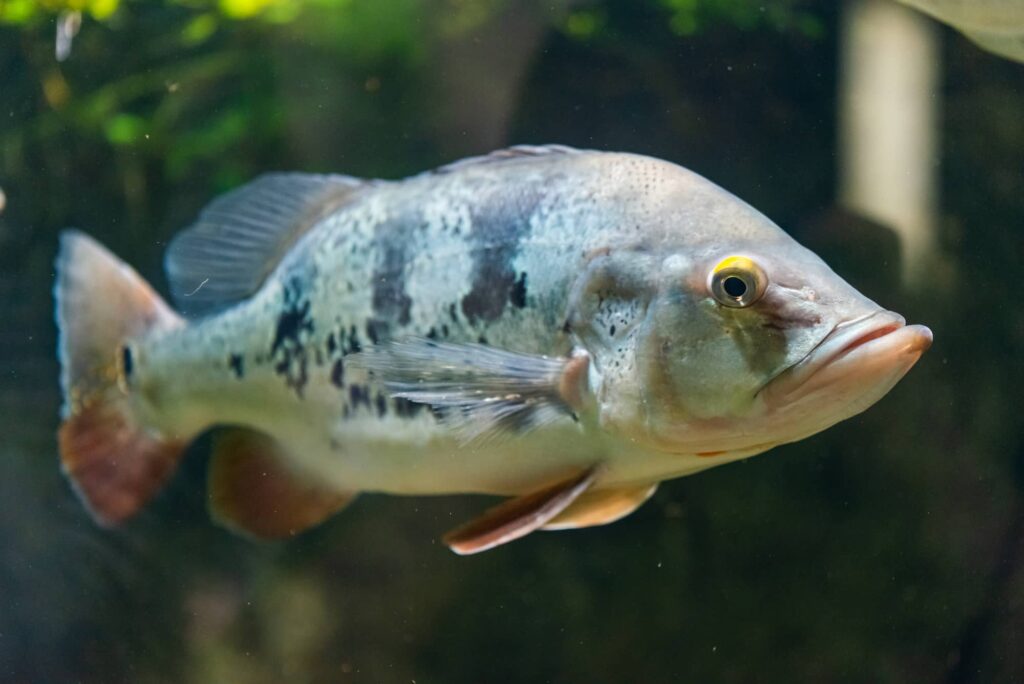Although you might not think that aggressive freshwater fish are suitable for life in an aquarium setting, some of the most popular tropical species are predatory.
Many predatory species of fish are quite safe to keep in a community set up when given the right tank mates and environment.
Read this guide to learn what makes predatory fish a good fit for many community tanks and discover 21 of our favorite species.
Tiger Barb
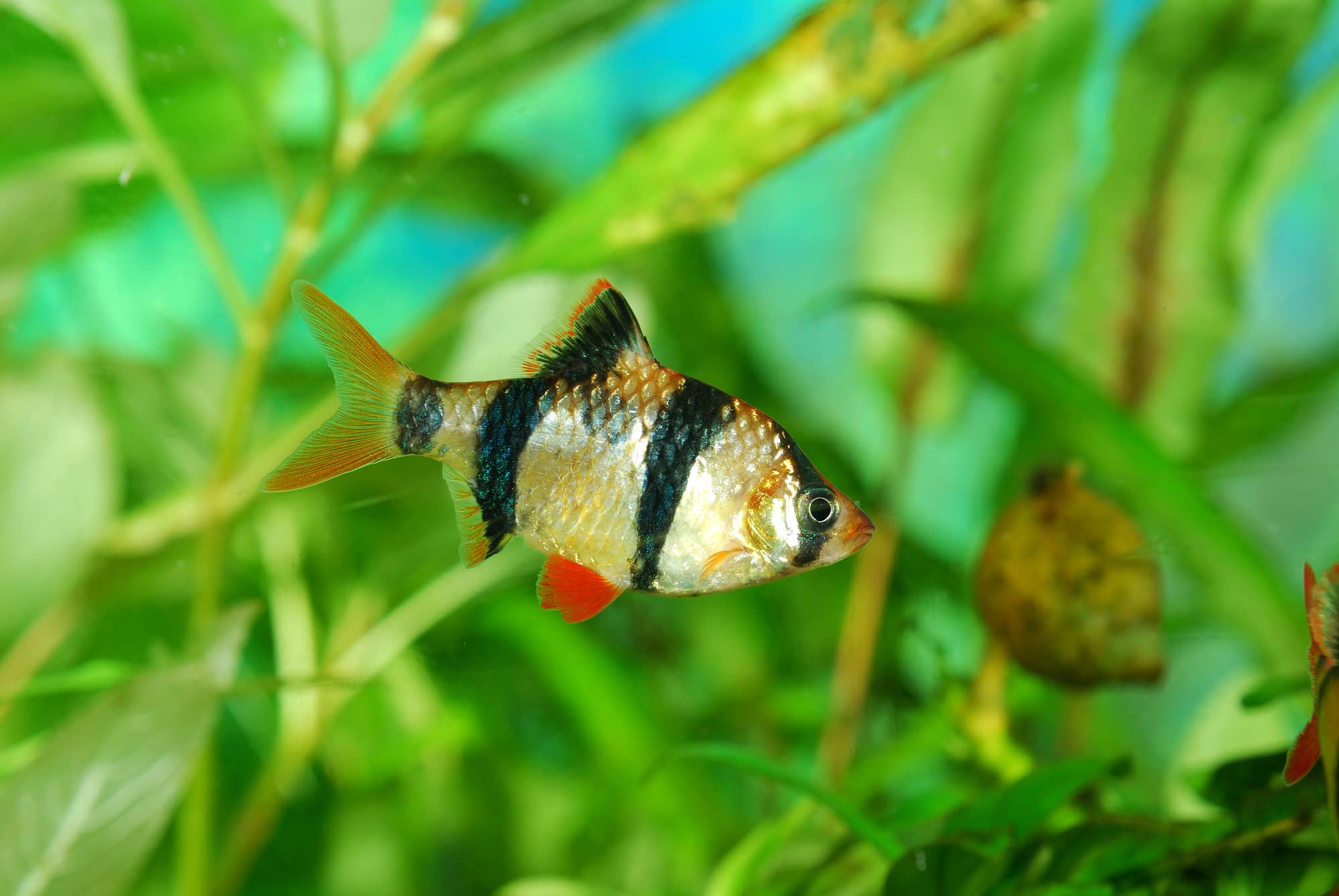
- Size: 3 inches
- Difficulty: Beginner/Intermediate
- Minimum tank size: 30 gallons
Tiger barbs are an extremely popular tropical fish, despite having a pretty bad reputation as being semi-aggressive fin nippers and bullies.
However, if you keep Tigers in a group of six or more, they are generally peaceful. It seems that the social interaction within the shoal prevents the fish from picking on their tank mates.
Red Tail Shark

- Size: 6 inches
- Difficulty: Intermediate
- Minimum tank size: 55 gallons
The Red Tail Shark is an extremely active, curious tropical fish that spends most of its time exploring the bottom of the tank. These fish need plenty of space and a well-decorated aquarium to thrive and keep their aggressive tendencies at bay.
In their natural habitat, these fish inhabit freshwater lakes and streams in Thailand. Sadly, Red Tail Sharks are considered to be critically endangered, but you can still find them in the aquarium trade.
Flowerhorn Cichlid
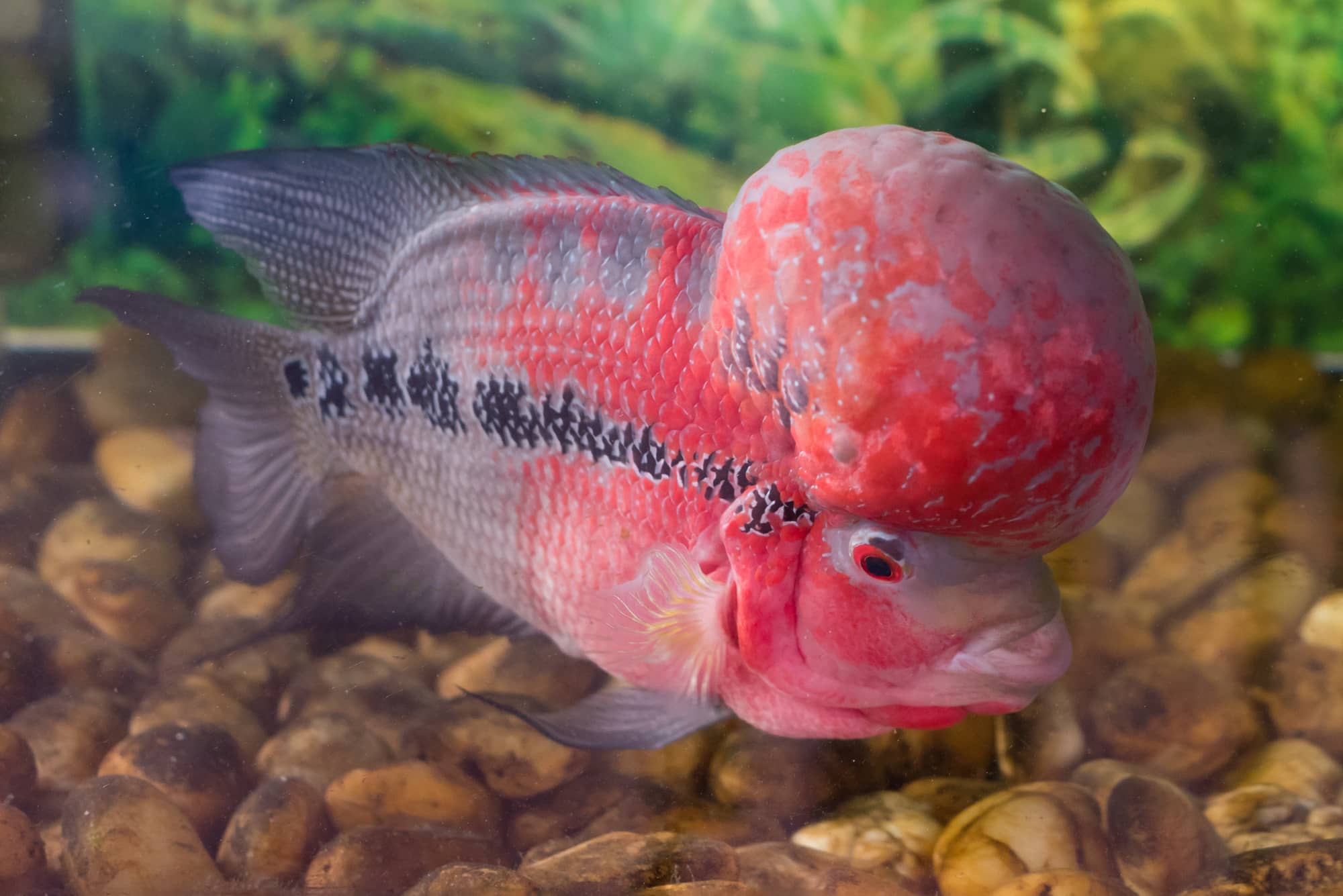
- Size: 12 to 16 inches
- Difficulty: Intermediate
- Minimum tank size: 70 gallons
Flowerhorn Cichlids are artificially created and don’t occur naturally in the wild, except in a few isolated populations where the fish have been released by their owners, having outgrown their tank.
These tropical fish don’t make good community members as they are highly aggressive and territorial. However, if you want to keep a single-species tank, these weird creatures can make fascinating pets.
Afer Knife
- Size: 20 to 30 inches
- Difficulty: Intermediate/expert
- Minimum tank size: 150 to 200 gallons
The Afer Knife fish are found all over central and western Africa, where they inhabit densely vegetated rivers. These monster fish are primarily bottom-dwellers, scoring the riverbed for prey.
In captivity, these carnivorous freshwater tank fish like dim lighting, dense plants, and plenty of driftwood.
Note: these predatory, exotic fish are not suitable for life in a community tank and are best kept alone.
Dwarf Pea Puffer
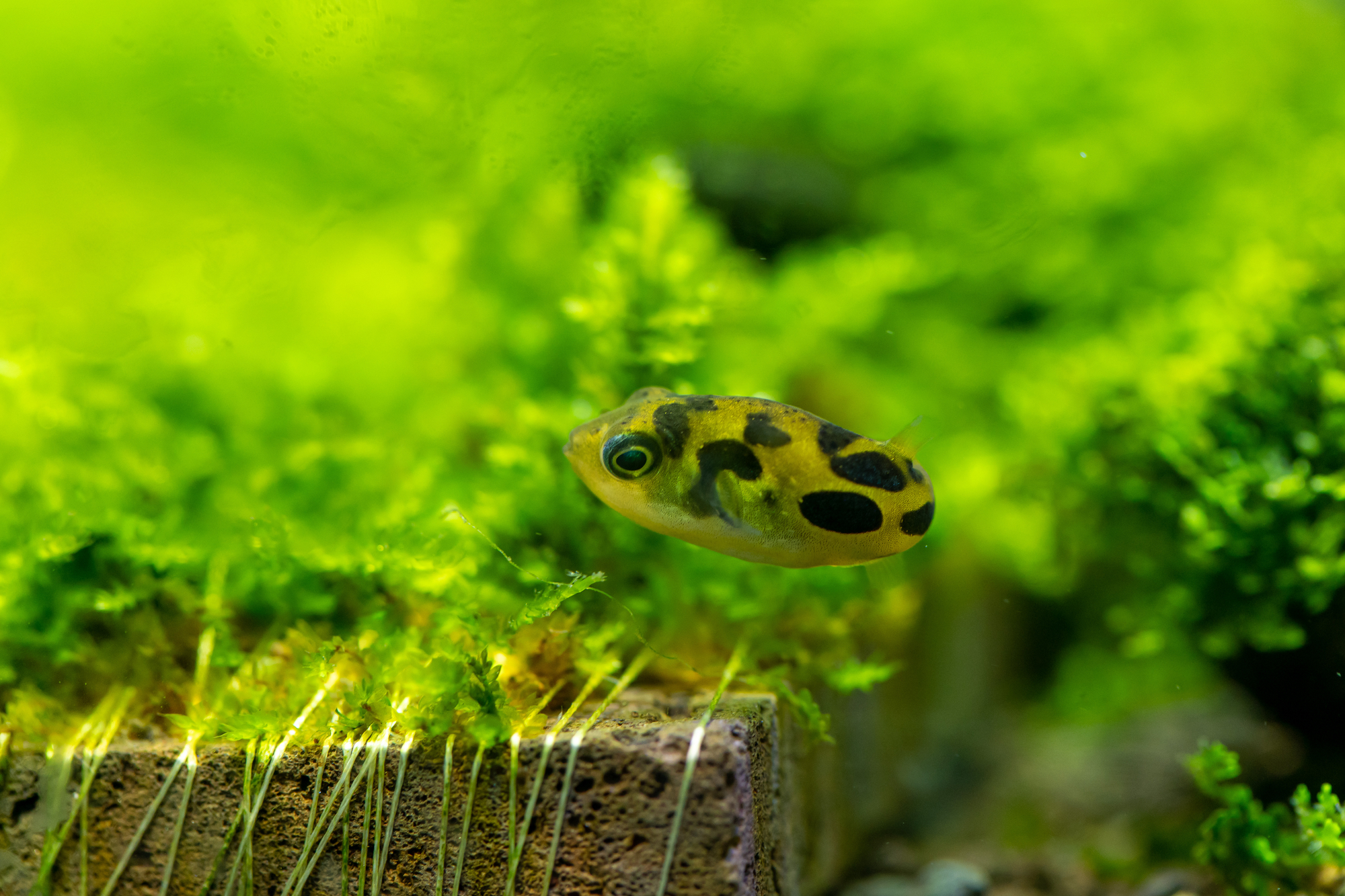
- Size: 1.5 inches
- Difficulty: Intermediate
- Minimum tank size: 10 gallons
The Dwarf Pea Puffer is another carnivorous freshwater tank fish that cannot live in a community setup.
These tiny fish are so cute to look at, you would never think that they could be so aggressive!
Although you could keep a few of these fish together in a single species tank, they are highly territorial, and disputes can break out. To keep the peace, you need to provide a well-decorated tank that’s filled with plenty of vegetation, rocks, and driftwood where the fish can take shelter.
Wolf Cichlid

- Size: 28 inches
- Difficulty: Intermediate
- Minimum tank size: 120 gallons
Wolf Cichlids are large, beefy fish that look intimidating. With their huge jaws, sharp teeth, and muscular bodies, these fish are not to be messed with!
Provide these monster fish with a large tank containing lots of plants for cover, as well as caves, rocky overhangs, and driftwood.
Black Wolf Fish
- Size: 20 inches
- Difficulty: Intermediate
- Minimum tank size: 120 gallons
The Black Wolf Fish is found throughout the Amazon River Basin. This aggressive fish species is a natural-born predator, lurking at the bottom of the water column waiting for prey to swim past.
Black Wolf Fish are apex predators that must live alone, although some fast-moving aggressive fish of similar size can sometimes make suitable tank mates.
Convict Cichlid
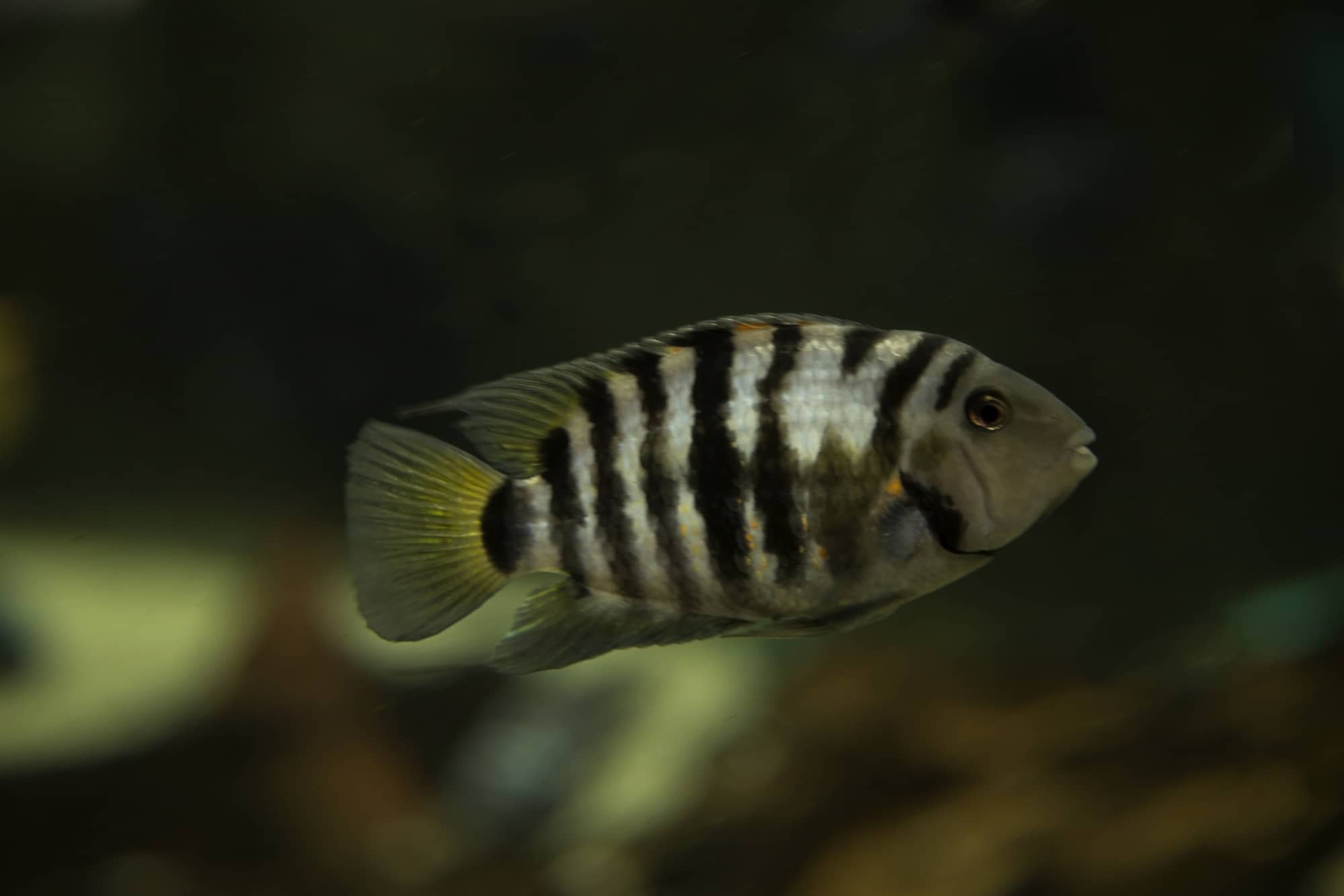
- Size: 4 to 5 inches
- Difficulty: Intermediate
- Minimum tank size: 30 gallons
The Convict Cichlid is an extremely popular and beautiful fish that many hobbyists keep in a community cichlid tank.
These are active fish that spend most of their time swimming in the middle of the water column, and with their silver-gray base color and vertical black stripes, it’s easy to see why the fish are so-named.
Although these exotic fish are aggressive, the Convict Cichlid is an easy species to keep, as long as you provide a large tank with lots of hiding places, including caves, rockwork, and driftwood.
Rainbow Shark

- Size: 6 inches
- Difficulty: Intermediate
- Minimum tank size: 50 gallons
Rainbow Sharks are members of the same family as minnows. However, these innocent-looking fish are very territorial, and that makes them semi-aggressive when another fish encroaches on their space.
To keep the peace, you’ll need to provide the Rainbow Shark with a well-decorated tank that includes lots of plants, rockwork, and hardscape. These are active fish that need plenty of swimming space to ensure that the aggression level is kept at bay.
Bichir
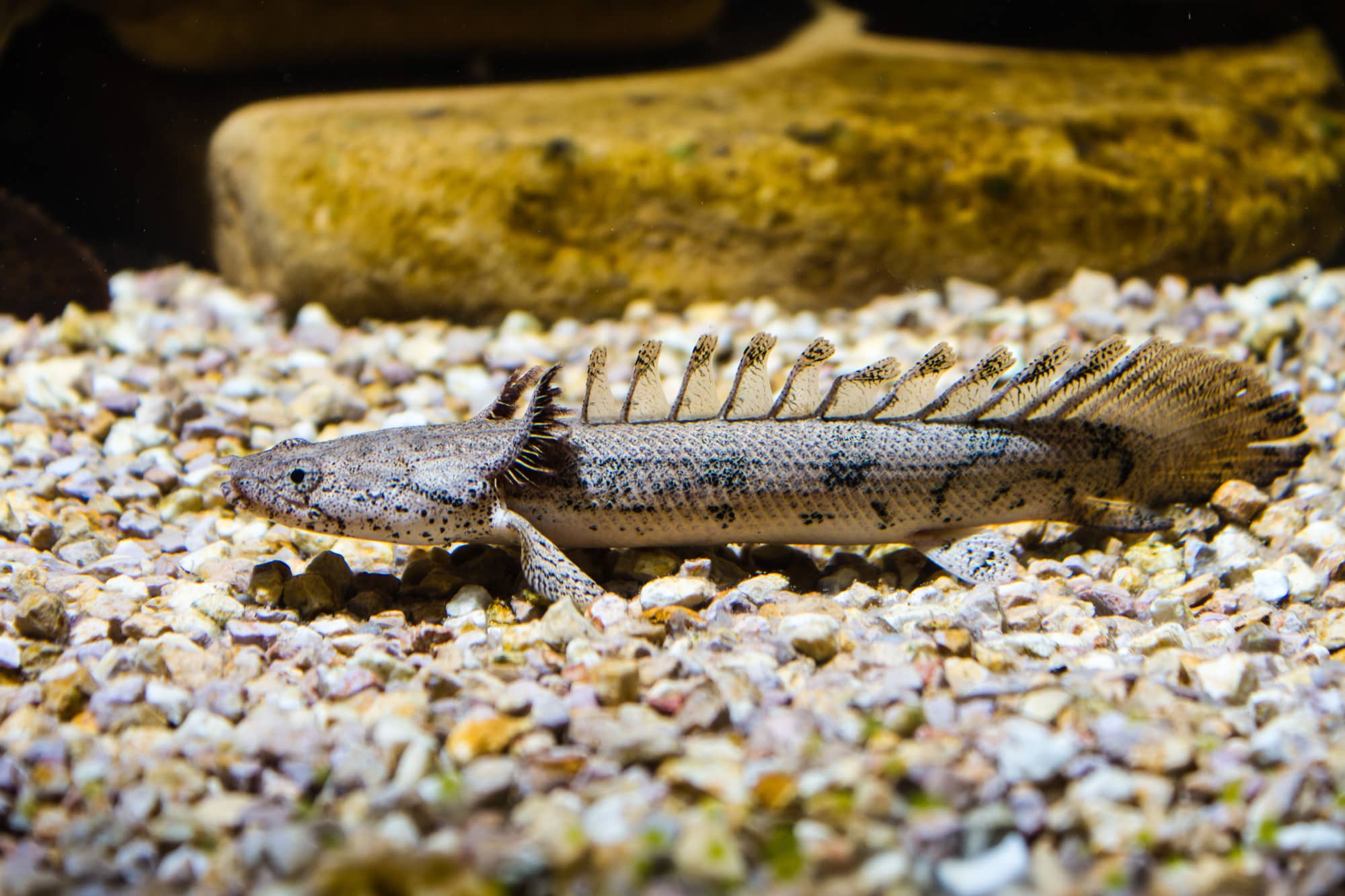
- Size: 1 to 2.5 feet
- Difficulty: Intermediate
- Minimum tank size: 90 gallons
The Bichir is a living fossil that can give your aquarium a unique look and makes a great talking point! These monster fish have been around for millions of years and can still be found in northeast Africa.
You’ll need to have a very large tank to keep one of these fish. That said, Bichirs are hardy creatures that can survive in a range of conditions, and they don’t demand a tank with lots of decorations either.
Bichirs are carnivores, and they can be aggressive toward small tank mates that might be regarded as food items. However, as long as you give this carnivorous fish plenty of live and frozen food, larger tank mates should be untroubled.
Hoplias Aimara
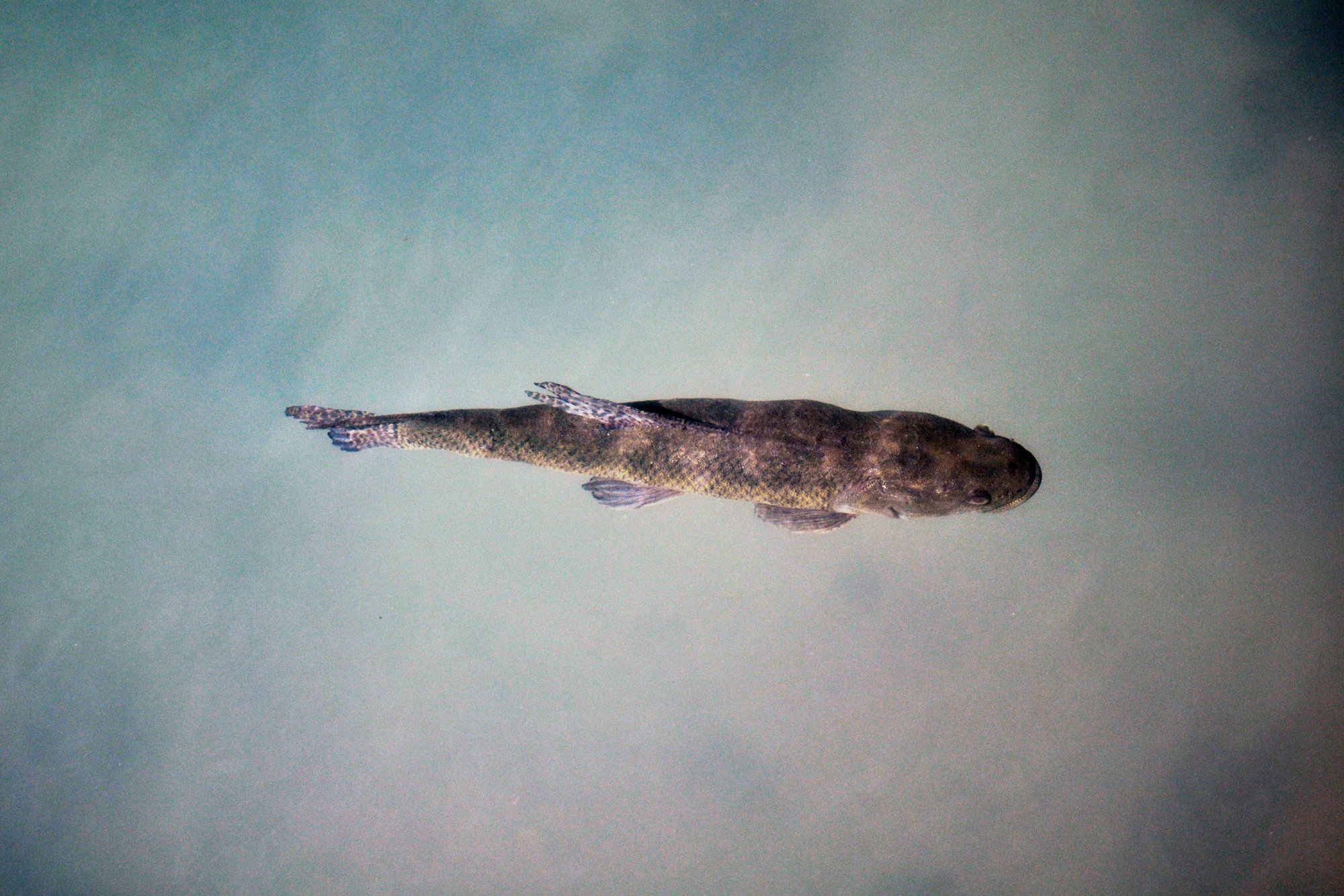
- Size: Over 30 inches
- Difficulty: Expert
- Minimum tank size: 300 gallons
This fish species is seldom seen in the aquarium trade, largely due to its unique needs. If you do take on one of these fierce predators, you’ll need a huge tank and plenty of experience in keeping similar fish species. Hoplias Aimara is also known as the Aimara Wolf Fish.
These animals are fierce predators and extremely active swimmers that are capable of chasing down their prey.
When kept in captivity, these fish spend much of their time resting on the substrate. However, these are relatively easy fish to keep and can thrive in the aquarium, provided they have plenty of space to swim when the mood takes them.
Red Devil Cichlid

- Size: 15 inches
- Difficulty: Intermediate
- Minimum tank size: 55 gallons
The Red Devil Cichlid is a charismatic fish that interacts with its owner and can even develop a strong bond with you, begging for food when hungry.
These are beautiful fish that are typically a brilliant bright red. There are also gray, white, yellow, and brown variants.
Although they are undoubtedly gorgeous to look at, Red Devil Cichlids are very aggressive and don’t mix well with other fish. They are also diggers that can wreak havoc with your plants and decorations.
Umbee Cichlid
- Size: 20 inches
- Difficulty: Intermediate/expert
- Minimum tank size: 180 gallons
The Umbee Cichlid is a beautiful fish that can add excitement to your aquarium, as their shimmering turquoise shades make a gorgeous display when kept in the right conditions.
Wild Umbee Cichlids inhabit streams and lakes where the environment is rocky. So, to keep the fish healthy and happy, you need to replicate that habitat in the aquarium. Add twisted roots, driftwood, and a wide range of lush planting, too.
Although you can keep these fish in bonded pairs for breeding, you can never house two males together, as that is sure to end in violence and injuries.
Silver Arowana
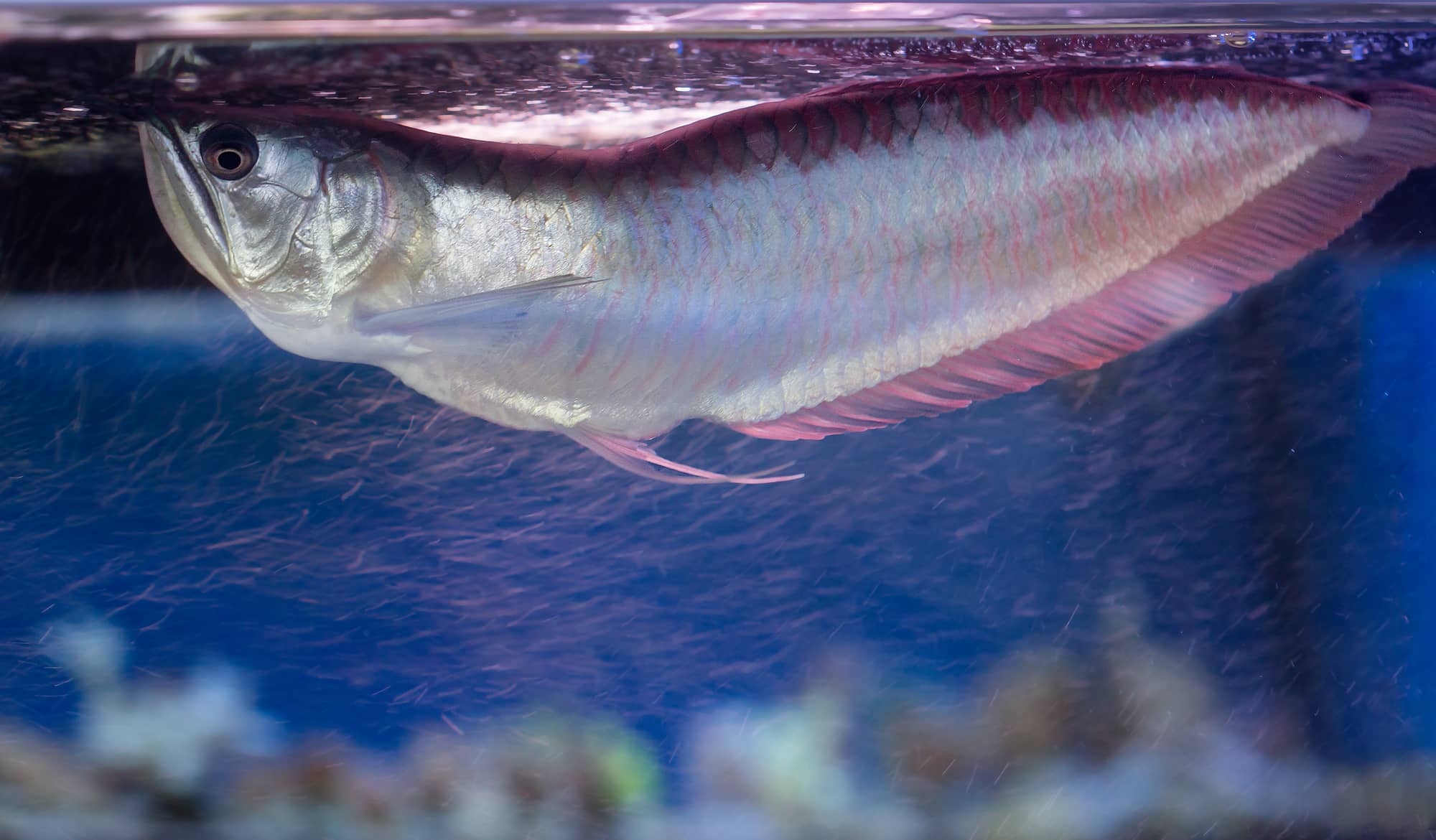
- Size: 3 feet
- Difficulty: Expert
- Minimum tank size: 250 gallons
If you want an aggressive and high-maintenance pet fish, the Silver Arowana is definitely where it’s at!
These fish are regarded by many aquarists as the ultimate challenge. Not only are they one of the most expensive species in the world, but they are also very challenging to keep healthy.
These are banded fish, having long, slender bodies that resemble a ribbon when viewed from the side and a long dorsal fin that runs from head to tail.
The Silver Arowana is just about the most predatory fish in the aquarium trade. These monsters have huge jaws that can grab and swallow a smaller fish in seconds. So, it’s usually best to keep these fish in captivity on their own rather than risking tank mates.
That said, you can keep a few suitable companions with a Silver Arowana, provided that you give these carnivorous fish plenty of fresh food and include lots of hiding places for their tank mates.
Texas Cichlid
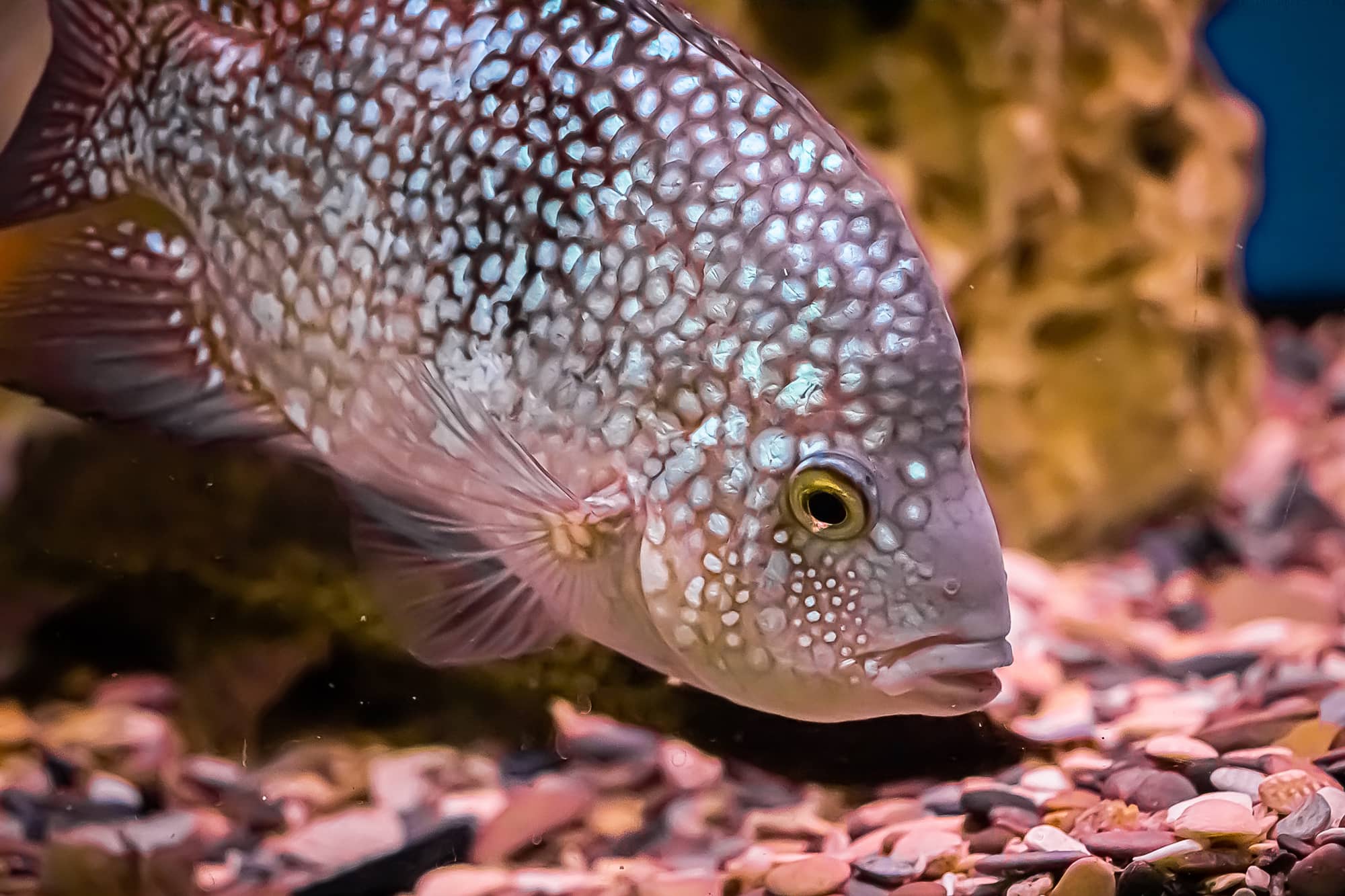
- Size: 12 inches
- Difficulty: Intermediate
- Minimum tank size: 50 gallons
Texas Cichlids originate from the Rio Grande and are some of the most attractive fish in captivity, adding glorious neon colors to your tank.
These fish are very agile swimmers, so they require plenty of open swimming space with a gravel and sand mixture for the substrate. You also need to include a few plants and rocks that don’t impinge too much on the open water area, as these cichlids prefer less dense planting and more open space.
As juveniles, the Texas Cichlid is relatively peaceful and will get along fine with other peaceful species. However, as the fish reach adulthood, behavioral problems can arise.
In the wild environment, Texas Cichlids live in solitude, but you can keep these fish in captivity with other aggressive species, provided you have a very large tank.
Peacock Bass Cichlid
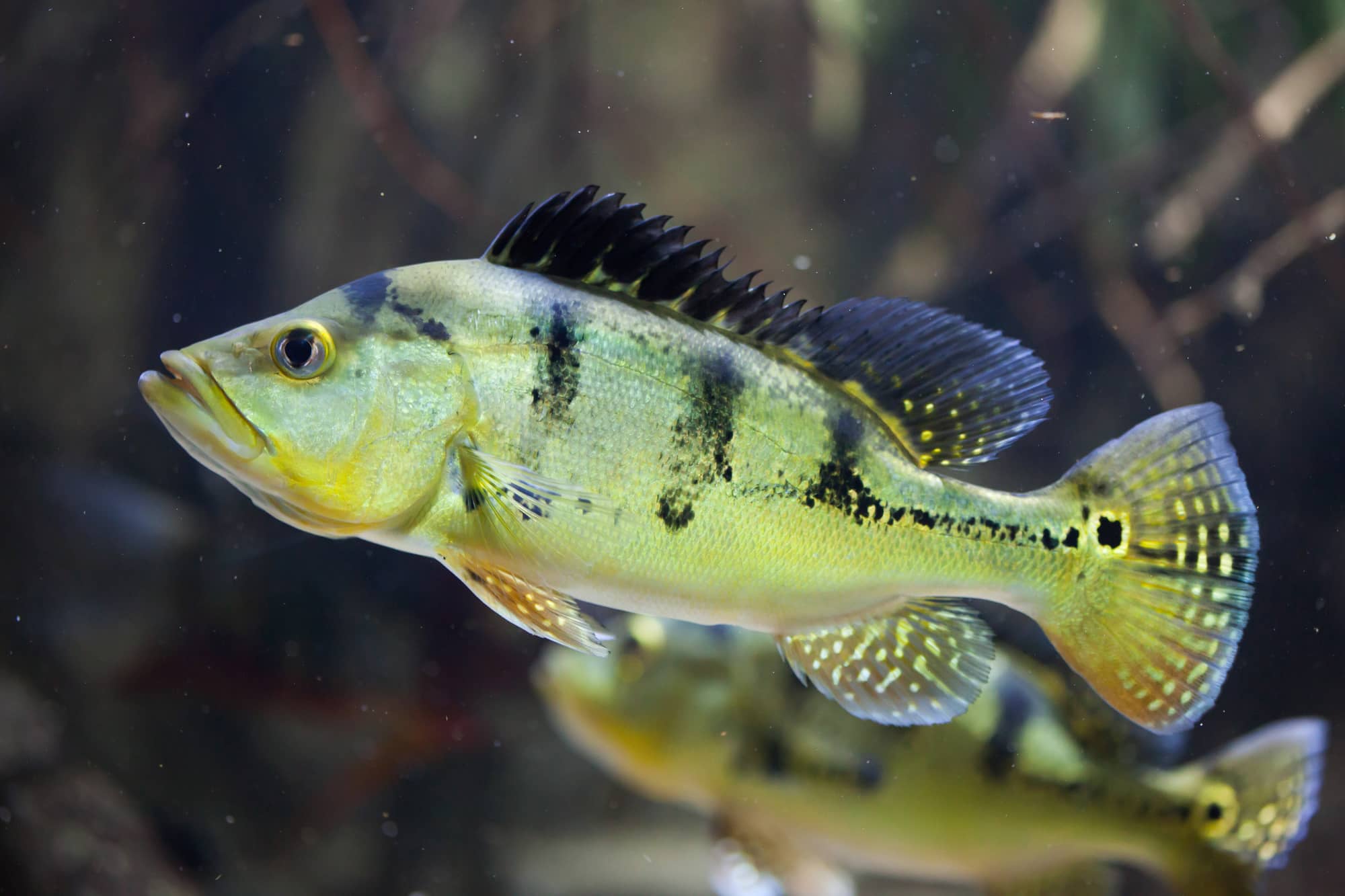
- Size: 30 inches
- Difficulty: Intermediate/Expert
- Minimum tank size: 200 gallons
The Peacock Bass Cichlid is often mistaken for the standard Bigmouth Bass. However, these fish belong to the Cichlidae family of fish.
These attractive fish are gorgeous to look at, being a mixture of olive green, bright yellow, white, and red, with a signature black eyespot on the tail.
They are used as game fish in parts of southern Florida, where they have been introduced to lakes and canals. Rather than being problematic as other alien species often are, the Peacock Bass has improved the populations of native fish species.
In the aquarium, the Peacock Bass Cichlid is a fish that can be something of a handful to keep. The fish are highly aggressive and they also produce a huge amount of waste. So, to keep the fish healthy, you’ll need an aquarium that’s fitted with a highly efficient, solid filtration system.
Oscar Fish
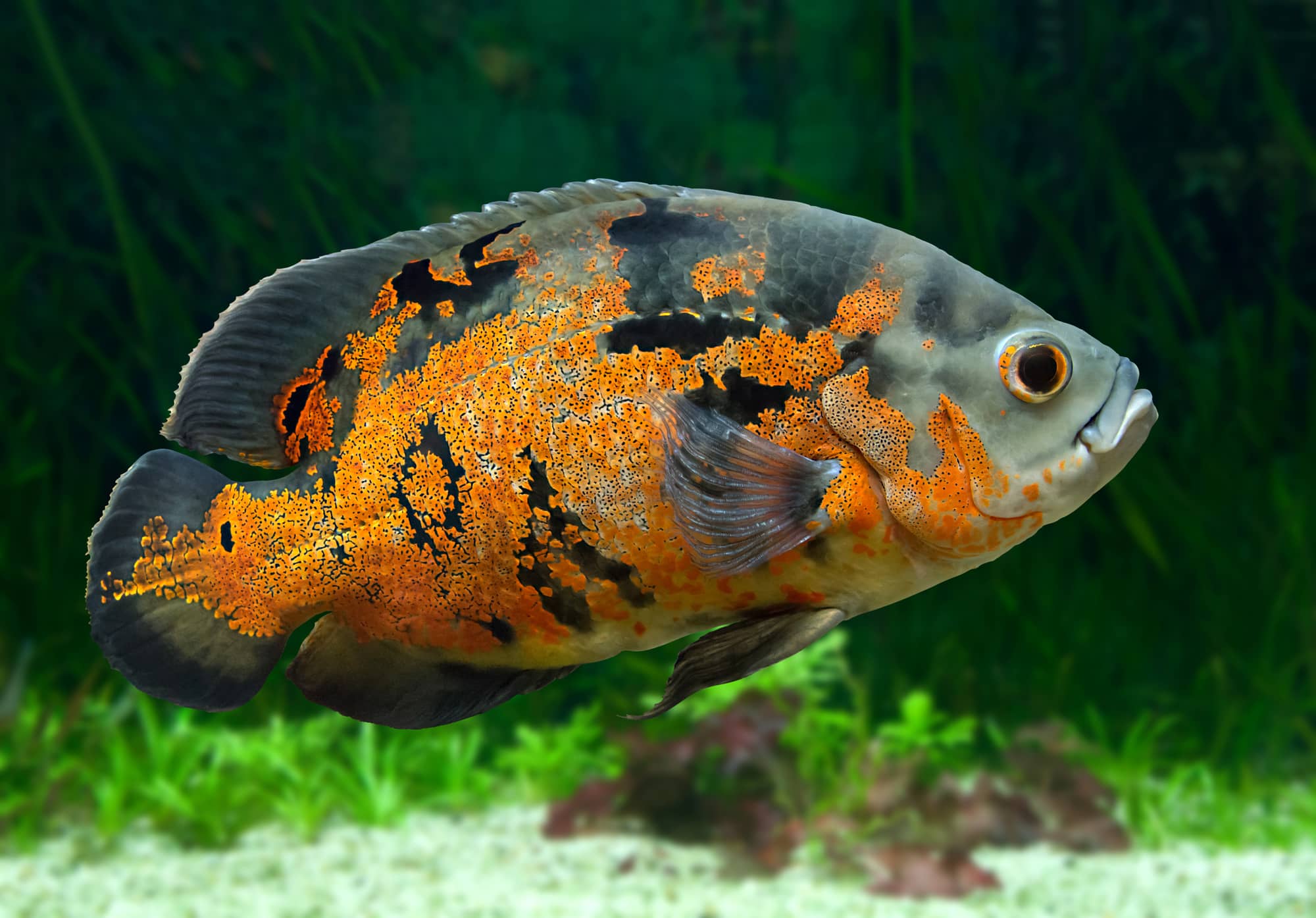
- Size: 10 to 12 inches
- Difficulty: Intermediate
- Minimum tank size: 55 gallons
The Oscar Fish is an iconic species of cichlid that almost everyone in the hobby will recognize. Oscars are also known as Velvet Cichlids and are one of the most popular fish in the trade.
The Oscar’s body is colored with a combination of gray, orange, and red that give these fish a truly unique appearance.
Generally, Oscar Fish are pretty easy to care for, and they adapt well to almost any conditions, provided you give them the water parameters they need. Also, unlike many carnivorous, predatory fish, the Oscar will accept some processed foods and plant matter.
The main problem with Oscar Cichlids is that they are known to be bullies that are prone to attacking and eating any vulnerable fish. So, if you decide to add a few tank mates to your Oscar’s tank, you need to choose other aggressive predatory species that can stand up to the Oscar Cichlid.
Jack Dempsey Fish
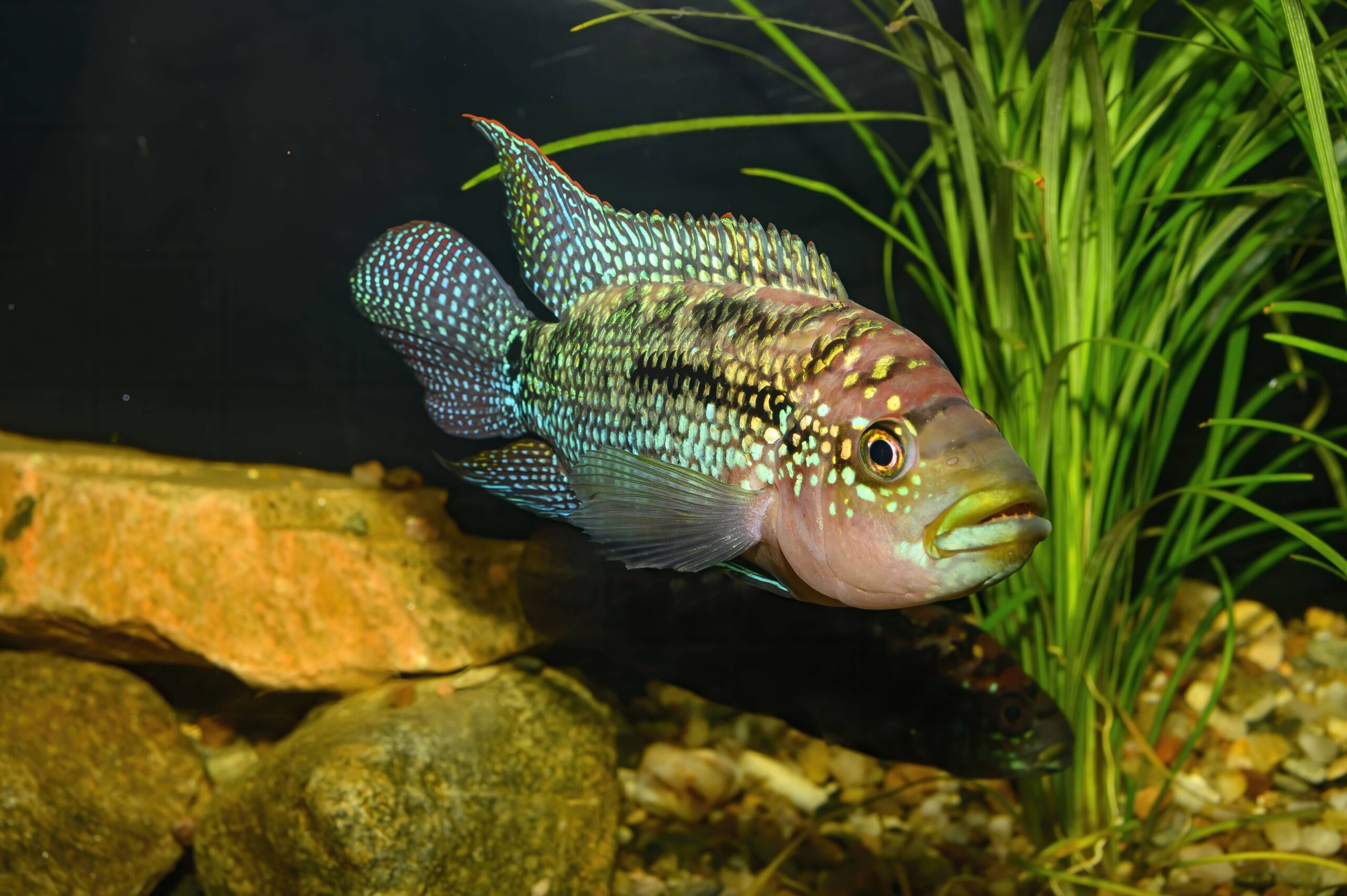
- Size: 10 to 15 inches
- Difficulty: Intermediate
- Minimum tank size: 55 gallons
The Jack Dempsey Fish is named after the famous boxer, thanks to its strong, prominent facial muscles and a sturdy body.
These are hardy fish that can do well in home aquariums. Jack Dempsey Fish can tolerate hotter tank temperatures than most other tropical fish species, so that gives you some flexibility in the event of a heater failure or if the ambient temperature rises above comfortable levels.
There are a few different variants of Jack Dempsey Fish to choose from. The most common variety seen in tanks is a beautiful fish, covered in purple, gold, and blue spots on top of a gray base color.
Since the Jack Dempsey Fish is a cichlid, they are quite aggressive. However, there are several more docile species to choose from. You can keep the peace in your aquarium by providing caves, driftwood, and a wide range of rocks to the environment.
Mini Dovii
- Size: 12 inches
- Difficulty: Beginner/Intermediate
- Minimum tank size: 75 gallons
The Mini Dovii is also known as the Sieve Cichlid. These are rare fish that make a gorgeous addition to the right aquarium.
The fish’s body is decorated with bright red dots that appear almost uniform, creating a distinct linear pattern along the side. To highlight the brilliant red coloration, the fish’s body is black, and the fins are edged with red.
The Mini Dovii is highly territorial, especially when there are several of the same species in the tank. You can keep these rare fish in company with other aggressive cichlid species, which generally mitigates aggression and fighting. Also, be sure to include lots of decorations to break up the fish’s lines of sight.
Final Thoughts
If you want to add an unusual, characterful species of fish to your aquarium, you might want to consider including an aggressive, predatory fish.
Many of these feisty characters have much to offer the experienced aquarist, and many of them are pretty easy to keep, too.
However, before taking on any of the species that we’ve suggested in this guide, we recommend that you research the fish thoroughly. Some carnivorous, predatory fish require a very specialized diet, and some can only live alone in a very large tank. So, always ensure that you can provide the fish with the conditions it needs to thrive before you commit to bringing one home.
Do you keep a predatory fish? Tell us in the comments box below.

